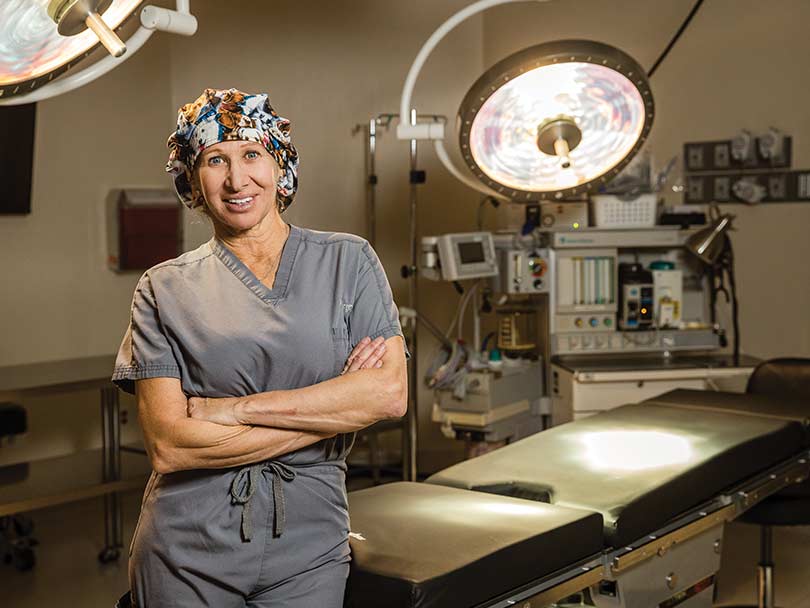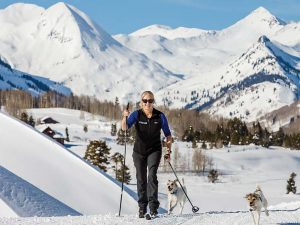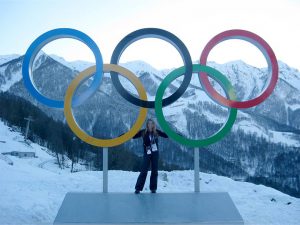Dr. Gloria Beim helps athletes put best foot forward.
By Eugene Buchanan –
When the 2022 Paralympics start in Beijing this March, athletes on the U.S. Team — especially those from Colorado — will have a leg up on their competition thanks to team physician Dr. Gloria Beim of Crested Butte.
In 1999, Dr. Beim founded Alpine Orthopaedics, now one of the top orthopaedic care practices on the Western Slope. Its mission: provide Olympic-level, affordable orthopaedic care to anyone who needs it.
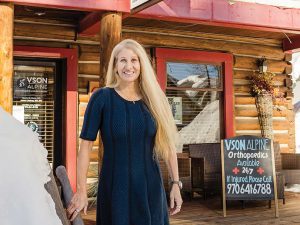
The doctor, Gloria Beim, is in at VSON Alpine Clinic in Crested Butte. Photo by Mountain Magic Media
“We put community first and take seriously our responsibility to provide personalized care to ensure our guests feel healthy, active, educated and supported,” says Dr. Beim, whose group provides top-level care for the regions of Telluride, Crested Butte and Gunnison, home of Gunnison County Electric Association.
For Beim, helping others has always been her life’s calling. Growing up in California’s San Fernando Valley, she skipped high school and started college at age 14 before attending medical school at the University of California San Diego. A residency at New York’s Columbia University and a fellowship at the University of Pittsburg Center for Sports Medicine saw her rise to the top of orthopaedic care, where she’s board-certified with additional training in complex knee, shoulder, joint and sports-related injuries.
It didn’t take long to put her training into action. She served as U.S. team physician for the 2004 Olympics in Athens; venue medical director for the 2012 Olympic Games in London; and chief medical officer for Team USA at the 2014 Winter Olympics in Sochi, Russia. This March’s 2022 Winter Paralympic Games in Beijing will also mark her fourth Paralympics, serving as chief medical officer in two and head team physician in two.
The roles caught the attention of her peers, with her practice recently merging with Vail Summit Orthopaedics and Neurosurgery. Like helping someone with a shoulder injury, the move has expanded her group’s reach even more.
“The patients will be the ones who benefit from this partnership,” says VSON CEO John Polikandriotis of the merger with Beim’s team. “Gloria has outstanding training in complex knee, shoulder, joint, and sports-related injuries and has performed surgery at the highest level on professional athletes. Her commitment and bedside manner are unrivaled, her patients adore her, and physician colleagues and professional sports organizations seek her knowledge regularly. She’s truly earned her reputation for excellence. Any team would be lucky to have her.”
For U.S. Paralympic athletes, that team hits the world’s biggest sports stage next month, with Dr. Beim on hand to help them perform their best. Colorado Country Life caught up with her before she heads across the Pacific for an inside look at working both the Olympics and Paralympics, as well as serving the GCEA region back home.
Q: What is your family status?
A: I am married with two kids: my daughter Skylar, 19, is in her second year at Cal Poly in San Luis Obispo studying kinesiology and my son, Jakob, 13, is in middle school in Crested Butte.
Q: What are your hobbies?
A: I love all sports but particularly alpine skiing, biking, hockey when I am not injured, and horseback riding — my greatest passion besides orthopaedics. I’m also a balloon animal artist. My kid and adult patients love this. I love art, particularly oil painting when I have time.
Q: What do you like about treating athletes and, in particular, Olympians?
A: I love treating athletes, whether elite or weekend warriors. They have so much incentive to get better and do what is needed to get there. They’re generally pretty healthy as well, which makes outcomes better whether surgery is indicated or not. They also usually have a really positive attitude and care very much about their health, which also makes outcomes better.
I remember treating workers’ comp patients back in New York when I was training and many of them were very unhealthy and had no desire to get better. They, therefore, often didn’t listen to their doctor when it came to eating healthier, taking their meds and doing PT. Here, on the other hand, most of my patients, particularly athletes, are all about doing everything to improve their outcomes and returning to work. Sometimes, they’re even a bit too eager to get back to work, especially if their work is on the ski slopes. I have to watch out for them as well.
Q: You’ve been to three Olympics and this will mark your fourth Paralympics; how will this one be different?
A: The Games in Tokyo last summer were very different in that there weren’t any fans for the athletes and there were so many COVID mitigation efforts that sometimes it was difficult for the athletes to focus on their sport. I usually will do everything in my power to help athletes not focus on anything but their sport, but this was challenging. I suspect it will be similar in Beijing this winter. I think the USOPC did a great job trying to include family and friends from afar during the Tokyo Games but it wasn’t the same. Also, since the Tokyo Games were postponed for a year, this is challenging to get ready for another Games in only five months.
Q: Can you describe a typical day for you at the Olympics?
A: I don’t get much sleep; I’m always on the run handling many different things. I try to visit all of the venues and hospital systems prior to the Games to make connections and be ready to help with any injuries from the venues. I also spend a lot of time in the USOPC sports medicine clinic to treat all comers. We have an amazing staff that travels with the team, including physicians, physical therapists, athletic trainers, massage therapists and more.
We set up a beautiful clinic for Team USA in our housing facility in the Olympic/ Paralympic Village with just about everything the athletes may need. I try to at least get a cup of coffee in before I start my day, but often I don’t eat much more than an energy bar or two before dinner because I’m so busy.
We rarely get to sleep before midnight and we realize it’s a marathon rather than a sprint, so we just have to keep going. But there is so much excitement and adrenaline being around these athletes that lack of rest isn’t really a problem for me.
Q: Any differences being a team physician for the Paralympics vs. Olympics?
A: There’s a huge difference. For many Paralympic athletes, in addition to common injuries in the sport, both traumatic and overuse, I also may have to treat their underlying conditions or disabilities. Whether it’s an amputee dealing with a problem with their stump, prosthesis or wheelchair, or a paraplegic having a medical emergency relating to temperature changes — it’s often another level of challenges to treat these athletes. But I absolutely love caring for them and the professional support system the USOPC has put in place to help them is second to none from any other country.
At the last Paralympic Games, I was the head team physician for venues for our team and also for Wheelchair Basketball. I was therefore present for every game for the men’s and women’s teams while also supporting medical providers in as many other venues as possible. When I take care of Paralympians, the inspiration they send to all of us is incredible and makes the job pretty easy. It’s a true honor to care for these superhumans.
Q: Are injuries from the Winter Olympics markedly different from those at the Summer Games?
A: At the Winter Games there are a lot more traumatic injuries in my experience than at the Summer Games. In Summer Games, we seem to be taking care of more overuse injuries, but there are crossovers as well. It also has to do with things like the venues and snow conditions. While there are many factors that can affect the injuries medical providers have no shortage of work.
Q: Any particular memories from injuries you’ve treated at past Olympics?
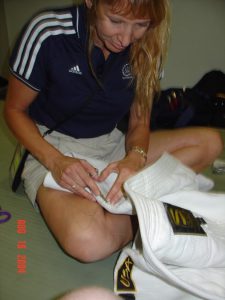
Dr. Beim puts her surgical skills to work to help an athlete cover an offending sports logo on her clothing.
A: There are so many. One of my proudest moments wasn’t really treating an injury but I did have to use my surgical skills. It was in my first Summer Olympics in Athens in 2004. I was the team doctor for Taekwondo and Cycling, but back then we pretty much treated all teams as needed. I was covering Judo and an athlete was ready to go into a bronze medal match. She had been wearing the same gi [martial arts garment] throughout the competition, but [that day] the judge didn’t allow her to wear it because it had a sports logo on it. Her competition was about to start and she was freaking out.
Since my job is to make the athletes feel comfortable so they only have to focus on their sport, I told her not to worry. I grabbed her gi, grabbed my suture kit and quickly sutured a white patch over the logo. Then I ran it back to the athlete, she put it on, the judge accepted it and she was able to compete. Even though it wasn’t an injury per se, it was one of my proudest moments. That’s what we do at the Games: be the team behind the team and do whatever it takes, even improvise, to help them attain their goal.
Q: Back home, what do you do to support your community?
A: The first thing is to deliver great care to locals and visitors. But we’ve also donated hundreds of thousands of dollars over the years to everything from kids’ sports teams — including soccer teams, ski teams and bike teams — as well as the adaptive sports program locally. We’ve also been a major sponsor for Western Colorado University to deliver free injury clinics and sports physical exams for athletes for over 25 years. I’ve also supported many other groups and causes in the Gunnison Valley, including support for cancer patients and mental health initiatives.
Q: Have you treated any Olympians from the Gunnison Valley area?
A: Yes, several. It‘s been exciting to see my own local patients, some of whom I’ve known since they were high school athletes, achieve their goals as Olympians and Paralympians.
Q: Your fellowship trained in sports medicine, including knee, shoulder, joint and sports-related injuries. Is that a good fit for being located in Crested Butte?
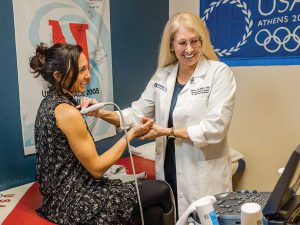
Dr. Beim looks at patient Bonnie McDonald’s shoulder when Bonnie visits the Crested Butte office. Photo by Mountain Magic Media.
A: It’s a great fit. Just about everyone here is an athlete in some manner. I would say 70% of my practice is treating shoulder and knee injuries, so my specialty training is perfect for this area. I also do a lot of trauma care, particularly for skiers, snowboarders and mountain bikers, but also for horse riders, ATVers and snowmobilers. There are so many ways to get injured around here that trauma experience and skills are pretty important.
Q: What do you like about living and practicing in the GCEA region of Crested Butte?
A: Crested Butte is absolute paradise. It is so beautiful here and the people are so lovely. It’s amazing to be part of this wonderful community and it’s a great place to raise children. Everyone is so healthy and positive here. Instead of kids hanging out in a mall like in the city, all the kids around here are involved in at least two sports all year round.
It’s also great to get out and enjoy the beauty and great sports here even if I have limited time. I’ve been here for over 25 years and can’t think of a better place to live and work. When I finished my training, I had job offers at UCLA, the Mayo Clinic and some other awesome institutions, but I happily passed them up to build a practice here in paradise.
Colorado and the athletes who enjoy the state’s mountains — summer and winter — have been the beneficiaries.
Eugene Buchanan, an outdoor writer based in Steamboat Springs, previously wrote about the electric co-ops’ connection to the Olympics last July.

